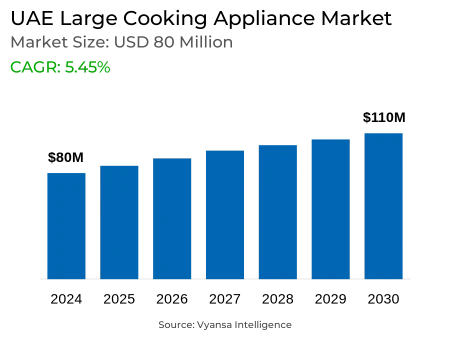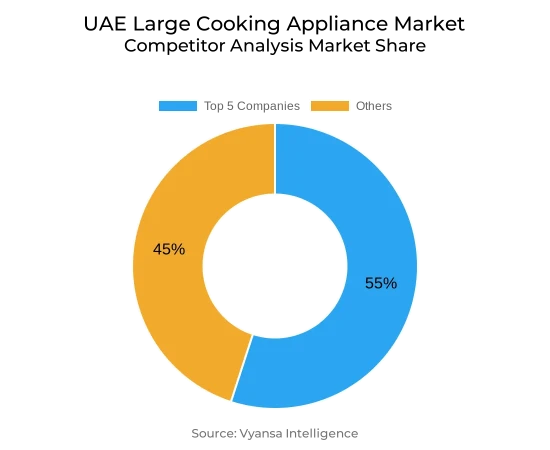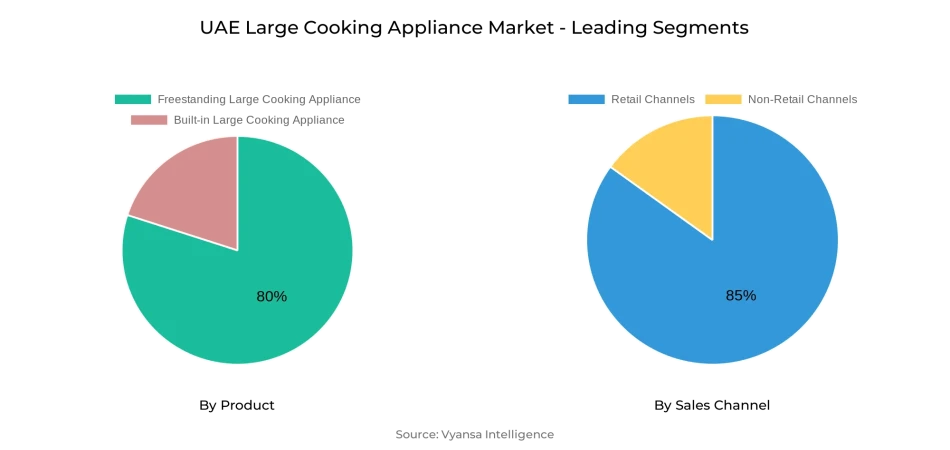
UAE Large Cooking Appliance Market Report: Trends, Growth and Forecast (2025-2030)
By Product (Built-in Large Cooking Appliance, Freestanding Large Cooking Appliance), By Application (Household, Commercial), By Sales Channel (Retail Channels, Non-Retail Channels)
- FMCG
- Oct 2025
- VI0047
- 110
-




UAE Large Cooking Appliance Market Statistics, 2025
- Market Size Statistics
- Large Cooking Appliance in UAE is estimated at $ 80 Million.
- The market size is expected to grow to $ 110 Million by 2030.
- Market to register a CAGR of around 5.45% during 2025-30.
- Product Shares
- Freestanding Large Cooking Appliances grabbed market share of 80%.
- Freestanding Large Cooking Appliances to witness a volume CAGR of around 4.2%.
- Competition
- More than 15 companies are actively engaged in producing Large Cooking Appliance in UAE.
- Top 5 companies acquired 55% of the market share.
- Teka Group, Beko Electronic AS, Midea Middle East, Hafet Electrical LLC, Aftron Electronics Ltd etc., are few of the top companies.
- Sales Channel
- Retail Channels grabbed 85% of the market.
UAE Large Cooking Appliance Market Outlook
The UAE large cooking appliance market is likely to see steady growth during 2025-2030, regardless of inflation affecting consumer behavior. Although most consumers are taking a conservative route towards spending on high-ticket items, demand is robust, particularly among more affluent consumers and in regions with high expatriate population. The boom in modular kitchens and growing interest in home cooking is persuading consumers to spend on high-quality, multifunctional, and durable appliances.
Built-in ovens, hobs, and hoods are increasingly in demand, especially in cities such as Dubai, Abu Dhabi, and Sharjah. This is being fueled by the thriving housing market and the growing preference for contemporary, streamlined kitchen designs. With new residential developments still going up, most are incorporating built-in appliances as a standard component in an effort to meet consumer desire for sleek and space-efficient solutions.
The e-commerce shift is another central trend driving the market. Web shopping of high-end and mid-level cooking appliances is increasing because of the convenience of home delivery, value pricing, and availability of product comparisons. Retailers are stepping up their web presence and providing special web-based promotions to engage more buyers, particularly thorough researchers prior to purchase.
Lastly, increasing demand for energy-saving and culturally relevant appliances is defining product innovation and design. Inflation pressure is compelling consumers to look for long-term value, which is spurring demand for energy-saving ovens and hobs. Concurrently, the multicultural population is driving demand for appliances appropriate for Middle Eastern and Asian cooking, including steam ovens, tandoori ovens, and high-BTU gas hobs.

UAE Large Cooking Appliance Market Growth Driver
UAE inflationary pressures will remain the driving force behind consumer expenditure patterns in 2025-30. Though increasing prices across major cooking appliances, there remains consistent demand for high-end, energy-efficient models, particularly from high-income consumers. Consumers are getting more prudent in their purchases and want appliances that will save them on energy expenses over the long term, even if they are pricier in the short term.
This preference change is propelling demand for energy-efficient ovens and hobs that provide quicker cooking times and multifunctionality. These features not only sustain energy savings but also improve cooking convenience. The premium segment, which has been presenting these efficient and advanced offerings, is expected to fare well since richer buyers increasingly value quality and sustainability over merely price.
UAE Large Cooking Appliance Market Trend
Even with price sensitivity caused by inflation, UAE consumers are increasingly turning to upscale cooking appliances. Most families, particularly those who are relatively affluent, are increasingly preferring superior products that provide cutting-edge technology, long-lasting durability, and classy looks. This clearly indicates a trend of premiumisation in the market.
Well-off consumers, especially, are spending more on upscale kitchen arrangements that reflect their lifestyle. To respond, a number of brands are launching elite product lines that merge contemporary features with elegant, high-end designs. This change is assisting brands in connecting with the luxury market and fulfilling consumers' requirements for quality and aesthetics within the interior of the home.
UAE Large Cooking Appliance Market Opportunity
The multicultural population of the United Arab Emirates, particularly with robust Middle Eastern and Asian groups, is impacting demand for large cooking appliances that accommodate certain culinary traditions. These are such things as high-BTU gas hobs employed for wok cooking, tandoori ovens, and steam ovens that are gaining traction in both domestic and foodservice outlets.
Consequently, stores are extending their appliance range to offer more culturally specific appliances. This change creates a good chance for brands to appeal to diverse cooking habits and expand their customer base through meeting the uniques of different ethnicities living in the country.
| Report Coverage | Details |
|---|---|
| Market Forecast | 2025-30 |
| USD Value 2024 | $ 80 Million |
| USD Value 2030 | $ 110 Million |
| CAGR 2025-2030 | 5.45% |
| Largest Category | Freestanding Large Cooking Appliances segment leads with 80% market share |
| Top Drivers | Rising Focus on Energy Efficiency Amid Inflation |
| Top Trends | Rising Preference for Premium Designs Despite Inflation |
| Top Opportunities | Rising Demand for Culturally-Specific Cooking Appliances |
| Key Players | Teka Group, Beko Electronic AS, Midea Middle East, Hafet Electrical LLC, Aftron Electronics Ltd, BSH Home Appliances FZE, Tecnogas Srl, Bertazzoni SpA, Electrolux AB, Beko Corp and Others. |
UAE Large Cooking Appliance Market Segmentation Analysis

The largest market share segment in the UAE Large Cooking Appliances Market in 2025–30 is Retail Channels, both offline and online. Of these, offline retail remains predominant because consumers are comfortable with physical verification and immediate availability of products. Most consumers still prefer going to showrooms to have a feel and see of appliances before making a purchase decision, particularly for large-ticket purchases.
Concurrently, e-commerce growth is quickly altering purchasing behavior. Customers are increasingly making online purchases of big cooking appliances owing to advantages such as home delivery, low prices, and extensive product comparisons. The trend is particularly robust in the mid-range and upper segments. Therefore, manufacturers and retailers are enhancing their online presence with special online offers to tap this increasing demand.
Top Companies in UAE Large Cooking Appliance Market
The top companies operating in the market include Teka Group, Beko Electronic AS, Midea Middle East, Hafet Electrical LLC, Aftron Electronics Ltd, BSH Home Appliances FZE, Tecnogas Srl, Bertazzoni SpA, Electrolux AB, Beko Corp, etc., are the top players operating in the UAE Large Cooking Appliance Market.
Frequently Asked Questions
Related Report
1. Market Segmentation
1.1. Research Scope
1.2. Research Methodology
1.3. Definitions and Assumptions
2. Executive Summary
3. UAE Large Cooking Appliance Market Policies, Regulations, and Standards
4. UAE Large Cooking Appliance Market Dynamics
4.1. Growth Factors
4.2. Challenges
4.3. Trends
4.4. Opportunities
5. UAE Large Cooking Appliance Market Statistics, 2020-2030F
5.1. Market Size & Growth Outlook
5.1.1.By Revenues in US$ Million
5.1.2.By Unit Sold in Thousand Units
5.2. Market Segmentation & Growth Outlook
5.2.1.By Product
5.2.1.1. Built-in Large Cooking Appliance- Market Insights and Forecast 2020-2030, USD Million
5.2.1.1.1. Built-in Hobs- Market Insights and Forecast 2020-2030, USD Million
5.2.1.1.1.1. Gas- Market Insights and Forecast 2020-2030, USD Million
5.2.1.1.1.2. Induction- Market Insights and Forecast 2020-2030, USD Million
5.2.1.1.1.3. Mixed- Market Insights and Forecast 2020-2030, USD Million
5.2.1.1.1.4. Standard Electric- Market Insights and Forecast 2020-2030, USD Million
5.2.1.1.1.5. Vitroceramic- Market Insights and Forecast 2020-2030, USD Million
5.2.1.1.2. Ovens- Market Insights and Forecast 2020-2030, USD Million
5.2.1.1.2.1. Smart- Market Insights and Forecast 2020-2030, USD Million
5.2.1.1.2.2. Non-Smart- Market Insights and Forecast 2020-2030, USD Million
5.2.1.1.3. Built-in Cooker Hoods- Market Insights and Forecast 2020-2030, USD Million
5.2.1.2. Freestanding Large Cooking Appliance- Market Insights and Forecast 2020-2030, USD Million
5.2.1.2.1. Freestanding Cooker Hoods- Market Insights and Forecast 2020-2030, USD Million
5.2.1.2.2. Cookers- Market Insights and Forecast 2020-2030, USD Million
5.2.2.By Application
5.2.2.1. Household- Market Insights and Forecast 2020-2030, USD Million
5.2.2.2. Commercial- Market Insights and Forecast 2020-2030, USD Million
5.2.3.By Sales Channel
5.2.3.1. Retail Channels- Market Insights and Forecast 2020-2030, USD Million
5.2.3.1.1. Retail Offline- Market Insights and Forecast 2020-2030, USD Million
5.2.3.1.2. Retail E-Commerce- Market Insights and Forecast 2020-2030, USD Million
5.2.3.2. Non-Retail Channels- Market Insights and Forecast 2020-2030, USD Million
5.2.3.2.1. Builder Merchants and Construction- Market Insights and Forecast 2020-2030, USD Million
5.2.4.By Competitors
5.2.4.1. Competition Characteristics
5.2.4.2. Market Share & Analysis
6. UAE Built-in Large Cooking Appliance Market Statistics, 2020-2030F
6.1. Market Size & Growth Outlook
6.1.1.By Revenues in US$ Million
6.1.2.By Unit Sold in Thousand Units
6.2. Market Segmentation & Growth Outlook
6.2.1.By Product- Market Insights and Forecast 2020-2030, USD Million
6.2.2.By Application- Market Insights and Forecast 2020-2030, USD Million
6.2.3.By Sales Channel- Market Insights and Forecast 2020-2030, USD Million
7. UAE Freestanding Large Cooking Appliance Market Statistics, 2020-2030F
7.1. Market Size & Growth Outlook
7.1.1.By Revenues in US$ Million
7.1.2.By Unit Sold in Thousand Units
7.2. Market Segmentation & Growth Outlook
7.2.1.By Product- Market Insights and Forecast 2020-2030, USD Million
7.2.2.By Application- Market Insights and Forecast 2020-2030, USD Million
7.2.3.By Sales Channel- Market Insights and Forecast 2020-2030, USD Million
8. Competitive Outlook
8.1. Company Profiles
8.1.1.Hafet Electrical LLC
8.1.1.1. Business Description
8.1.1.2. Product Portfolio
8.1.1.3. Collaborations & Alliances
8.1.1.4. Recent Developments
8.1.1.5. Financial Details
8.1.1.6. Others
8.1.2.Aftron Electronics Ltd
8.1.2.1. Business Description
8.1.2.2. Product Portfolio
8.1.2.3. Collaborations & Alliances
8.1.2.4. Recent Developments
8.1.2.5. Financial Details
8.1.2.6. Others
8.1.3.BSH Home Appliances FZE
8.1.3.1. Business Description
8.1.3.2. Product Portfolio
8.1.3.3. Collaborations & Alliances
8.1.3.4. Recent Developments
8.1.3.5. Financial Details
8.1.3.6. Others
8.1.4.Tecnogas Srl
8.1.4.1. Business Description
8.1.4.2. Product Portfolio
8.1.4.3. Collaborations & Alliances
8.1.4.4. Recent Developments
8.1.4.5. Financial Details
8.1.4.6. Others
8.1.5.Bertazzoni SpA
8.1.5.1. Business Description
8.1.5.2. Product Portfolio
8.1.5.3. Collaborations & Alliances
8.1.5.4. Recent Developments
8.1.5.5. Financial Details
8.1.5.6. Others
8.1.6.Teka Group
8.1.6.1. Business Description
8.1.6.2. Product Portfolio
8.1.6.3. Collaborations & Alliances
8.1.6.4. Recent Developments
8.1.6.5. Financial Details
8.1.6.6. Others
8.1.7.Beko Electronic AS
8.1.7.1. Business Description
8.1.7.2. Product Portfolio
8.1.7.3. Collaborations & Alliances
8.1.7.4. Recent Developments
8.1.7.5. Financial Details
8.1.7.6. Others
8.1.8.Midea Middle East
8.1.8.1. Business Description
8.1.8.2. Product Portfolio
8.1.8.3. Collaborations & Alliances
8.1.8.4. Recent Developments
8.1.8.5. Financial Details
8.1.8.6. Others
8.1.9.Electrolux AB
8.1.9.1. Business Description
8.1.9.2. Product Portfolio
8.1.9.3. Collaborations & Alliances
8.1.9.4. Recent Developments
8.1.9.5. Financial Details
8.1.9.6. Others
8.1.10. Beko Corp
8.1.10.1. Business Description
8.1.10.2. Product Portfolio
8.1.10.3. Collaborations & Alliances
8.1.10.4. Recent Developments
8.1.10.5. Financial Details
8.1.10.6. Others
9. Disclaimer
| Segment | Sub-Segment |
|---|---|
| By Product |
|
| By Application |
|
| By Sales Channel |
|
Research Methodology
This study followed a structured approach comprising four key phases to assess the size and scope of the electro-oxidation market. The process began with thorough secondary research to collect data on the target market, related markets, and broader industry context. These findings, along with preliminary assumptions and estimates, were then validated through extensive primary research involving industry experts from across the value chain. To calculate the overall market size, both top-down and bottom-up methodologies were employed. Finally, market segmentation and data triangulation techniques were applied to refine and validate segment-level estimations.
Secondary Research
The secondary research phase involved gathering data from a wide range of credible and published sources. This step helped in identifying industry trends, defining market segmentation, and understanding the market landscape and value chain.
Sources consulted during this phase included:
- Company annual reports, investor presentations, and press releases
- Industry white papers and certified publications
- Trade directories and market-recognized databases
- Articles from authoritative authors and reputable journals
- Gold and silver standard websites
Secondary research was critical in mapping out the industry's value chain and monetary flow, identifying key market segments, understanding regional variations, and tracking significant industry developments.
Other key sources:
- Financial disclosures
- Industry associations and trade bodies
- News outlets and business magazines
- Academic journals and research studies
- Paid industry databases
Primary Research
To validate secondary data and gain deeper market insights, primary research was conducted with key stakeholders across both the supply and demand sides of the market.
On the demand side, participants included decision-makers and influencers from end-user industries—such as CIOs, CTOs, and CSOs—who provided first-hand perspectives on market needs, product usage, and future expectations.
On the supply side, interviews were conducted with manufacturers, industry associations, and institutional participants to gather insights into current offerings, product pipelines, and market challenges.
Primary interviews provided critical inputs such as:
- Market size and revenue data
- Product and service breakdowns
- Market forecasts
- Regional and application-specific trends
Stakeholders consulted included:
- Leading OEM and solution providers
- Channel and distribution partners
- End users across various applications
- Independent consultants and industry specialists
Market Size Estimation and Data Triangulation
- Identifying Key Market Participants (Secondary Research)
- Goal: To identify the major players or companies in the target market. This typically involves using publicly available data sources such as industry reports, market research publications, and financial statements of companies.
- Tools: Reports from firms like Gartner, Forrester, Euromonitor, Statista, IBISWorld, and others. Public financial statements, news articles, and press releases from top market players.
- Extracting Earnings of Key Market Participants
- Goal: To estimate the earnings generated from the product or service being analyzed. This step helps in understanding the revenue potential of each market player in a specific geography.
- Methods: Earnings data can be gathered from:
- Publicly available financial reports (for listed companies).
- Interviews and primary data sources from professionals, such as Directors, VPs, SVPs, etc. This is especially useful for understanding more nuanced, internal data that isn't publicly disclosed.
- Annual reports and investor presentations of key players.
- Data Collation and Development of a Relevant Data Model
- Goal: To collate inputs from both primary and secondary sources into a structured, data-driven model for market estimation. This model will incorporate key market KPIs and any independent variables relevant to the market.
- Key KPIs: These could include:
- Market size, growth rate, and demand drivers.
- Industry-specific metrics like market share, average revenue per customer (ARPC), or average deal size.
- External variables, such as economic growth rates, inflation rates, or commodity prices, that could affect the market.
- Data Modeling: Based on this data, the market forecasts are developed for the next 5 years. A combination of trend analysis, scenario modeling, and statistical regression might be used to generate projections.
- Scenario Analysis
- Goal: To test different assumptions and validate how sensitive the market is to changes in key variables (e.g., market demand, regulatory changes, technological disruptions).
- Types of Scenarios:
- Base Case: Based on current assumptions and historical data.
- Best-Case Scenario: Assuming favorable market conditions, regulatory environments, and technological advancements.
- Worst-Case Scenario: Accounting for adverse factors, such as economic downturns, stricter regulations, or unexpected disruptions.
Partnering With Industry Leaders to Drive Growth
Our mission is to deliver intelligence that matters. By combining data, analysis, and industry expertise, we enable organizations to make smarter, faster, and more impactful decisions. Whether it’s a Fortune 500 company or a high-growth startup, businesses trust us to provide clarity in an ever-evolving marketplace.






